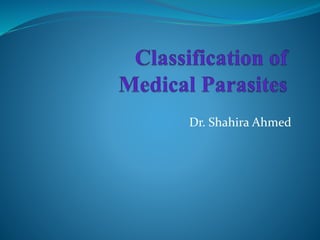
Classification of medical parasites
- 2. Learning Objectives 1. Outline the classification of medically important parasites. 2. List types of medically important helminthes. 3. Differentiate between types of helminthes according to: – General morphological characters. – Organs of fixation. – Habitat. – General outline of the life cycle. – Important stages in the life cycle. 4. List types of medically important protozoa. 5. List general characters of protozoa. 6. Differentiate between types of protozoa according to: – Locomotororgans. – Habitat. – General outline of the life cycle and important stages.
- 3. • What makes parasites different from other microorganisms? •Multiple life stages 1.Different immune response. 2.Difficult to formulate vaccine. 3.Difficult to control
- 4. Outline the classification of medically important parasites •Classification of medically important parasites –Helminthology. –Protozoology. –Entomology.
- 5. List types of medically important helminthes • Types of medically important helminthes –Trematodes –Cestodes –Nematodes •Intestinal nematodes •Tissue nematodes
- 6. Differentiate between types of helminthes A-Trematodes (Flukes) 1-General morphological characters. •Hermaphrodite except blood flukes (Unisexual) •Leaf-like, flattened and bilaterally symmetrical •There is no body cavity. 2-Organs of fixation: Almost all have 2 suckers, oral (at the anterior end, around the mouth) and ventral (on the ventral surface). Heterophyes has its genital pore surrounded by a muscular ring called genital sucker.
- 7. A-Trermatodes 3- Habitat: They have different habitat; intestinal, hepatic, blood and pulmonary flukes. 4-General outline of the life cycle. •Adult → egg → miracidium → sporocyst→ redia→ cercaria → metacercaria→ adult. •Egg is operculated, and should reach to a water source to hatch. •The first intermediate host is snail, and the second (if present) is marine creature. •Except for Schistosoma, egg has a spine, no redia and no metacercaria.
- 8. A-Trermatodes 5-Important stages in the life cycle. •The diagnostic stage is the egg. •The infective stage is the encysted metacercaria except in Schistosoma, it is the cercaria. •The mode of infection is by ingestion of food contaminated with the infective stage except in Schistosoma, it is by skin penetration of the cercaria.
- 9. B-Cestodes(tapeworms) 1-General morphological characters. • Hermaphrodite. • Ribbon-like flattened and bilaterally symmetrical. • There is neither body cavity nor digestive tract. • The body is formed of 3 parts: • Head (Scolex) which is provided by organs of attachment. • Neck is composed of actively dividing cells (stem cells) and it is responsible for giving rise to new segments. • Body is composed of several segments (Immature, Mature and Gravid segments).
- 10. 2-Organs of fixation: 2 types: •Suckers (4) with or without hooks that are arranged in one or more circles on the apex of the scolex called “rostellum”. •Bothria (2) that take the form of grooves. 3-Habitat: They all (without exception) are intestinal parasites. B-Cestodes(tapeworms)
- 11. 4-General outline of the life cycle. •Adult → egg → cysticercus (the larval stage) → adult, Except for D. latum, give oval operculated egg containing hexacanthembryo (coracidium). •All cestodes require one intermediate host (usually vertebrate), except D. latum requires two intermediate hosts. H. nana does not require an intermediate host. B-Cestodes(tapeworms)
- 12. 5-Important stages in the life cycle. •The diagnostic stage is the egg. •The infective stage is the last larval stage which is different according to: No intermediate host (H. nana): Egg. 1 intermediate host (Other cestodes): Cysticercus 2 intermediate hosts (D. latum): Pleurocercoid. •The mode of infection is by ingestion of food contaminated with the infective stage. B-Cestodes(tapeworms)
- 13. C-Nematodes (cylindrical worms) 1-General morphological characters. Bilateral symmetrical Has body cavity Separate sexes Elongate and cylindrical 2-Organs of fixation are present in the mouth and buccal cavity as lancets and teeth. 3-Habitat: Intestinal (small and large) and tissue nematodes. 4-General outline of the life cycle. •Adult → egg → larva → adult. •Tissue nematodes are viviparous (lay larvae). Larva molts its cuticle 3 times.
- 14. C-Nematodes (cylindrical worms) Intestinal nematodes Tissue nematodes Larva 2 rhabditiform and filariform. Larva called Microfilaria Intermediate host No intermediate host Essential to complete life cycle Egg Immature except Entrobious vermecularis No egg
- 15. C-Nematodes (cylindrical worms) Intestinal nematodes Tissue nematodes Diagnostic stage Egg or Larva Microfilaria Infective stage Egg containing larva or filariform larva Infective microfilaria Mode of infection Ingestion of food contaminated with the infective stage or skin penetration Ingestion or bite of the infective vector 5-Important stages in the life cycle.
- 16. Types of medically important protozoa Pseudopodia. Flagellates. Ciliates. Coccidia.
- 17. 1- General characters of protozoa •Body is formed of cytoplasm and nucleus. •Cytoplasm is differentiated into ectoplasm and endoplasm. •Nucleus contains karyosome and peripheral chromatin.
- 18. 1- Pseudopodia Locomotororgans: Pseudopodia. Habitat: Intestinal and free living. General outline of the life cycle and important stages: Trophozoite and cyst. 2- Ciliates Locomotororgans: Cilia. Habitat: Intestinal. General outline of the life cycle and important stages: Trophozoite and cyst.
- 19. 3- Flagellates General morphological characters: Flagella as Locomotororgans. Habitat:Intestinal, urogenitaland, blood. General outline of the life cycle and important stages: •Intestinal and urogenitalflagellates: Trophozoite and cyst. •Blood flagellates: •Leishmania: Amastigotes (in human) and promastigotes (Vector). • Trypanosoma:Trypomastigotes (human) and Epimastigotes (Vector).
- 20. 4-Coccidia Locomotororgans:They are sporulated. They are members of Apicomplexa. Habitat: Intestinal, tissue and blood. General outline of the life cycle: Gametogony (Sexual reproduction). Important stages in the life cycle: Sporozoite, Schizont, merozoite, gametocytes, oocyst.
- 21. Thank you